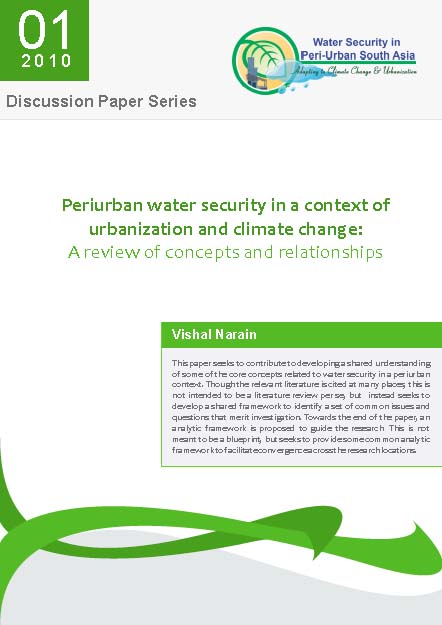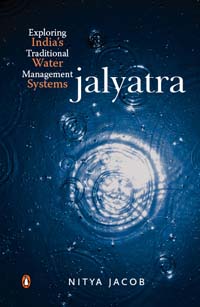/sub-categories/books-and-book-reviews
Books and Book Reviews
Bringing water to your door step - Urban water reforms for the next decade – A report by Price Waterhouse Coopers
Posted on 20 May, 2011 09:01 PM This report by Price Waterhouse Coopers India Limited for the Second Annual India Water Conference in April 2011 presents its view on urban water reforms for the next decade. India is still at an early stage of the urbanisation process and will witness exponential growth in many of its cities over the next few decades. By 2030 the urban population is expected to reach more than 590 million. This will put enormous pressure on all existing resources, especially water. Despite sufficient availability of raw water, many of its cities struggle to provide more than a few hours of water supply.
This report by Price Waterhouse Coopers India Limited for the Second Annual India Water Conference in April 2011 presents its view on urban water reforms for the next decade. India is still at an early stage of the urbanisation process and will witness exponential growth in many of its cities over the next few decades. By 2030 the urban population is expected to reach more than 590 million. This will put enormous pressure on all existing resources, especially water. Despite sufficient availability of raw water, many of its cities struggle to provide more than a few hours of water supply.
Improving water availability in the cities requires addressing complex policy, institutional and funding challenges. The core of the new approach will include instituting a new era of greater accountability and a performance-driven approach. Service delivery to urban poor has to be an integral part of this approach to bring about greater inclusiveness.
Recent experience with Public-Private-Partnerships (PPP) in urban water supply shows that with a customer focused approach and demonstration of clear benefits, there will be greater political and public acceptability of private participation. At the same time, fiscal framework at the local level has to be considerably strengthened before attempting wide scale replication of PPP.
Peri-urban water security in a context of urbanization and climate change - A review of concepts and relationships by SaciWaters
Posted on 17 May, 2011 04:05 PM
It is a part of the peri-urban water security project discussion paper series that aims at having a collection of research papers relevant to the concepts and processes involved in the project that represent preliminary ideas circulated to encourage discussion and comments.
Though the relevant literature is cited at many places, this is not intended to be a literature review per se, but instead seeks to develop a shared framework to identify a set of common issues and questions that merit investigation.
The paper argues that peri-urban can be better understood in terms of its characteristics - a mix of agricultural and non-agricultural land uses, flows of goods, services and resources between villages and urban centers and a social profile that is very heterogeneous and in a state of flux. All these impact upon the local natural resource base, creating particular environmental and natural resource management problems that are often beyond the scope of urban or rural governments alone and require innovative ways of being addressed.
Groundwater management in Andhra Pradesh - Time to address real issues – A report by Institute for Resource Analysis and Policy
Posted on 17 May, 2011 02:16 PMWith 49 per cent of the total irrigation from groundwater, the state of Andhra Pradesh accounts for 5.3 per cent of the net groundwater irrigated area in the country.
Groundwater scenario in major cities of India – A report by Central Ground Water Board
Posted on 17 May, 2011 10:35 AM It covers varying groundwater scenarios in the country including the highly developed metros, the hilly region, the coastal cities, the cities tapping unconsolidated and hard rock aquifers. The report briefly describes the administrative set up, status of water supply and demand, groundwater scenario, feasibility of rainwater harvesting and groundwater development strategy.
It covers varying groundwater scenarios in the country including the highly developed metros, the hilly region, the coastal cities, the cities tapping unconsolidated and hard rock aquifers. The report briefly describes the administrative set up, status of water supply and demand, groundwater scenario, feasibility of rainwater harvesting and groundwater development strategy.
It is an updated version of an earlier report on “Groundwater in urban environment in India” (2000). Since then, groundwater regime, urban demography and water demand have changed enormously. This report will form a scientific base for an in-depth understanding of urban groundwater system including aquifer geometry, water level behavior and groundwater quality. The possibility of artificial recharge to rejuvenate the urban aquifers has also been discussed.
Jalyatra: Exploring India's traditional water management systems
Posted on 14 May, 2011 07:34 PM Jalyatra - Exploring India's traditional water management systems, by Nitya Jacob is an ecological travelogue that looks at links between water, society and places It describes in detail what existed, how it fitted into the socio-cultural milieu and was appropriate for the local climate and geography. It then examines reasons for their decline, as indeed most have, in recent decades.
Jalyatra - Exploring India's traditional water management systems, by Nitya Jacob is an ecological travelogue that looks at links between water, society and places It describes in detail what existed, how it fitted into the socio-cultural milieu and was appropriate for the local climate and geography. It then examines reasons for their decline, as indeed most have, in recent decades.
While recording the dismal state of traditional systems, the author stumbles upon small initiatives that have brought about significant transformation across regions. It refers to noisy hidrums and gharaats, the river-run flour mills of Uttaranchal, the technologies whose potential has yet to be fully realised. It looks at water harvesting structures of southern India—the eris and ooranis. However, it admits that the average person is singularly uninterested in protecting the environment.
Jalyatra captures the efforts of NGOs and enlightened individuals striving to revive these systems. It makes the case for a mass movement to revive traditional water management systems, especially village ponds, across the country as the way to ensure water security in India. In Chambal, the author meets Brij Mohan Gujjar, dacoit turned water conservationist, who is doing valuable work on the check dams designed to control the flow of water in the ravines; and in Shillong, Lan Potham shows him the uses of the easily available bamboo to construct the shyngiar which irrigates his areca nut plantation.
Estimation of groundwater resources in Andhra Pradesh - A report by the State Groundwater Department - GoAP (2002)
Posted on 14 May, 2011 05:19 PMThe sustainable development and management of the resource requires precise quantitative assessment based on valid scientific principles. The updated Groundwater Estimation Committee methodology – 1997 has been used and detailed guidelines were formulated through discussions and deliberations in the State Level Groundwater Estimation Committee.
Hydrology and quality of groundwater in and around Bangalore city - Review and excerpts from the report released in March 2011, by the Department of Mines and Geology (Govt of Karnataka)
Posted on 10 May, 2011 08:34 PMA welcome and important document, it brings up-to-date our understanding of the rapidly changing groundwater situation in Bangalore.
| Month | New borewells added each month | Borewells registered with BWSSB | Monthly % growth |
| Jan-09 | 91018 | ||
| Feb-09 | 924 | 91942 | 1.02 |
| Mar-09 | 705 | 92647 | 0.77 |
| Apr-09 | 965 | 93612 | 1.04 |
| May-09 | 1136 | 94748 | 1.21 |
| Jun-09 | 748 | 95496 | 0.79 |
| Jul-09 | 904 | 96400 | 0.95 |
| Aug-09 | 868 | 97268 | 0.90 |
| Sep-09 | 2062 | 99330 | 2.12 |
| Oct-09 | 838 | 100168 | 0.84 |
| Nov-09 | 875 | 101043 | 0.87 |
| Dec-09 | 2699 | 103742 | 2.67 |
| Jan-10 | 1759 | 105501 | 1.70 |
| Total as on Jan-2010 | 14483 | 105501 | 15.91 |
Growth of bore wells during February 2009 to January 2010 in Bangalore city
Sunderbans - A climate adaptation report by World Wildlife Fund India
Posted on 09 May, 2011 09:23 PM Beginning in 2005, WWF-India has conducted dozens of personal interviews to record how climate change impacts people's lives here and now. These perceptions demanded that s
Beginning in 2005, WWF-India has conducted dozens of personal interviews to record how climate change impacts people's lives here and now. These perceptions demanded that s
"In Search of Yamuna: Reflections on a River Lost" - A recent book as an ode to rivers
Posted on 27 Apr, 2011 02:26 PMAbout the book
 In the present mood of transience and conflict, amidst the emerging riverfront politics, these communities seem to be caught in the eye of the storm.
In the present mood of transience and conflict, amidst the emerging riverfront politics, these communities seem to be caught in the eye of the storm.
History of irrigation in Bihar – Ancient, British and upto Pre-plan Period – A report by the Water and Land Management Institute, Patna
Posted on 23 Apr, 2011 10:29 AMIrrigation is being practiced there since ancient times dating back to Kautilya, who lived in Patliputra (now Patna), which was the capital of the mighty Mauryan empire (400 BC). Kautilya had laid down the principles on rainfall and irrigation in his famous book Kautilya Arthasashtra.